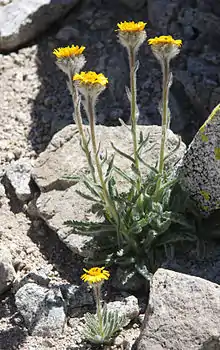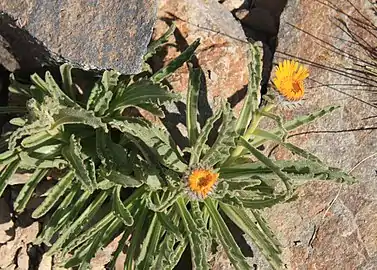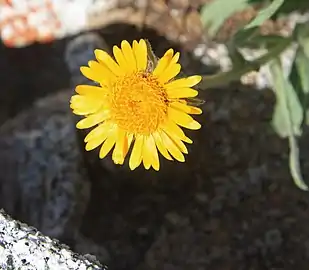Hulsea algida
Hulsea algida is a species of flowering plant in the daisy family, known by the common name Pacific hulsea or alpine gold. It is native to the western United States.
| Hulsea algida | |
|---|---|
 | |
| Kings Canyon National Park, California | |
| Scientific classification | |
| Kingdom: | Plantae |
| Clade: | Tracheophytes |
| Clade: | Angiosperms |
| Clade: | Eudicots |
| Clade: | Asterids |
| Order: | Asterales |
| Family: | Asteraceae |
| Genus: | Hulsea |
| Species: | H. algida |
| Binomial name | |
| Hulsea algida | |
| Synonyms[1] | |
| |
Description
H. algida is a hairy, glandular perennial herb producing stout erect stems approaching 40 centimeters (16 inches) in height. The dark green leaves are narrow and covered in white hairs, and the edges are wavy and toothed. Most of the leaves occur in a thick patch at the base of the plant, where they can reach 15 cm (6 in) in length,[2] and some grow from the stems.[3]
Appearing from July to September, the pseudanthium (flower head) is encased in a cup of densely woolly reddish green phyllaries which open to reveal a daisy-like bloom 5–9 cm (2–3+1⁄2 in) wide.[2] The center of the head is filled with yellow or orange disc florets and the circumference has up to 60 bright yellow or gold ray florets each about 1 cm long with rounded or toothed tips.[3] The fruit is an achene up to 1 cm long with a pappus which may be longer.[3]
H. nana is similar, but rarely more than 10 cm (4 in) tall, with a leafless stalk and 21 ray flowers per pseudanthium.[2]
 Top view of flowers opening
Top view of flowers opening Flower close-up
Flower close-up
Distribution and habitat
The species is native to California, Oregon, Nevada, Idaho, Montana, and Wyoming.[4] Within California, it grows in the Sierra Nevada and in the White Mountains. It grows between 2,900 and 4,300 metres (9,500 and 14,000 feet) in elevation, in alpine and subalpine talus habitats.[5]
References
- The Plant List, Hulsea algida A.Gray
- Spellenberg, Richard (2001) [1979]. National Audubon Society Field Guide to North American Wildflowers: Western Region (rev ed.). Knopf. pp. 380–381. ISBN 978-0-375-40233-3.
- Flora of North America, Hulsea algida A. Gray, 1865. Pacific or alpine alpinegold
- Biota of North America Program 2014 county distribution map
- Calflora taxon report, University of California: Hulsea algida, Pacific hulsea, high mountain hulsea . accessed 2.2.2013
External links
 Media related to Hulsea algida at Wikimedia Commons
Media related to Hulsea algida at Wikimedia Commons- Jepson Manual Treatment — Hulsea algida
- United States department of Agriculture Plants Profile: Hulsea algida (alpine gold)
- Hulsea algida — Calphotos Photo gallery, University of California